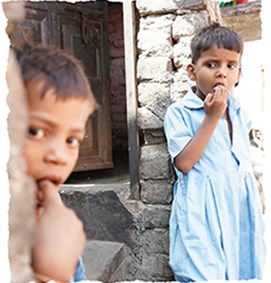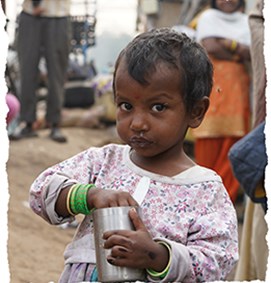Street children in India
- Date: 16 August 2021
- In: India
We have worked with street children in India for over 25 years, but why are there children on the streets of India in the first place? How do they survive, and what are the risks they face every day? In this article we have spoken to the CEO of Railway Children India, Navin Sellaraju, to find out more about who these children are, why they end up living on the streets, and how our work is trying to tackle this growing problem.
India is a huge country, with a massive population, many of whom sadly live in poverty. Often families live hand to mouth and barely have enough money to cover rents and food, with adults working in menial jobs for a daily wage. If something happens to disrupt this fragile source of income, desperation and hunger often force children to the streets as a means to survival.
In difficult circumstances children often see living on the streets as a better way to exist. The bright lights of big cities appeal to those living in hardship in rural areas and many flee to the urban areas looking for work, opportunities, or simply adventure. Children regularly run away from homes where life is just too difficult for them as so many families are trapped in generational cycles of:

It is hard to know precisely the number of children living on the streets in India, but the last time a nationwide study was done it was suggested that there are over 11 million (as published by UNICEF in 1991), although that figure is said to be a substantial underestimation.

Many resort to begging for money or food – which is why the country’s rail systems are an ideal place for them to go. There are plenty of passers-by and it is sheltered and busy. But it is not always easy for these children to get enough to eat and often they turn to crime in desperation, stealing food from stalls or getting involved in gangs. Often they are exploited into even worse situations than those they escaped from at home such as being forced into child labour or marriage.
When children are separated from their family unit they are vulnerable to abuse and many face violence every day. While living on the streets the lifestyle these children are forced to endure has detrimental effects on their:
They are prone to health problems as they have no access to sanitation and even basic medical care and poor diet and malnutrition is common.
They also have no access to school so fall behind in their studies, meaning they have little or no chance of every improving their situations and finding new opportunities. Many children are keen to gain an education, but have no way to do so.
India’s politicians and policymakers are aware of the huge issue of street children the country faces and have several strategies in place to tackle the problem. The mandates surrounding the Juvenile Justice (Care and Protection of Children) Act of 2015 includes street children and the Integrated Child Protection Scheme (ICPS) specifically addresses the needs of street children. It includes policies to provide shelter, nutrition, healthcare, counselling, guidance and referral services, non-formal education programmes and vocational training amongst other services for street children. Railway Children works closely with authorities to ensure these policies are supported and protections are upheld.
Our teams are based at stations across India to identify and protect vulnerable children as soon as they arrive in the cities. We make sure they are safe, fed, clothed and address any medical needs before trying to find out why they have ended up alone and at risk. Wherever possible we reunite them with their families, explaining to both the children and their parents the dangers of them being alone. We help families understand the importance of children’s welfare and education and try to re-enrol children back into school so they can progress academically and have the opportunity of a better life. We also run awareness campaigns to try and change public perception of children on the streets and lobby governments for better support for them and their families.
Find out more about what we do>
Find out how you can get involved >
Find out about more about our impact >